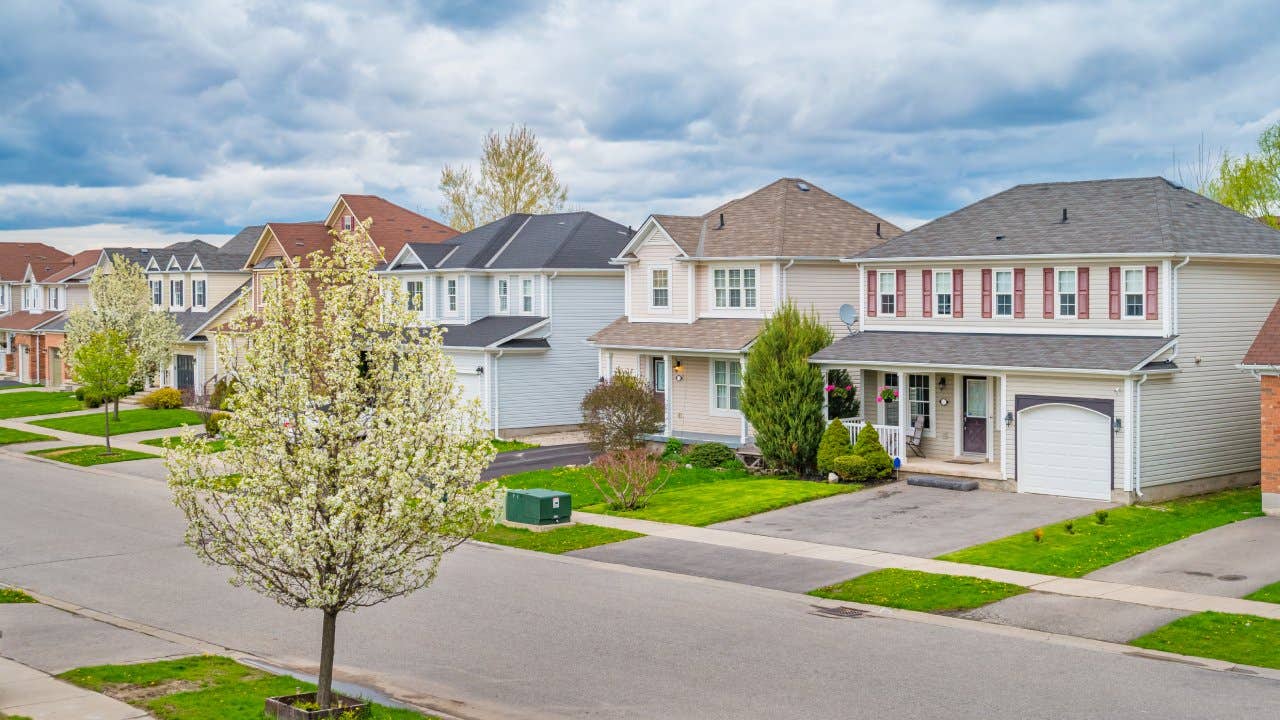Should you get an adjustable-rate mortgage?

The Bankrate promise
At Bankrate we strive to help you make smarter financial decisions. While we adhere to strict , this post may contain references to products from our partners. Here's an explanation for .
Key takeaways
- Adjustable-rate mortgages (ARMs) have gained popularity as interest rates have risen.
- ARMs carry slightly lower rates than fixed-rate mortgages.
- If you expect rates to fall, or plan to move before the initial fixed-rate period expires, getting an ARM can make sense.
With mortgage rates trending up and home prices still climbing, more borrowers are looking to adjustable-rate mortgages. This type of mortgage can be a more affordable means to get into a home, especially as higher rates on fixed mortgages begin to price some borrowers out — but is it worth the risk? Here’s how to know if you should get an adjustable-rate mortgage.
Why ARMs are popular right now
Adjustable-rate mortgages, or ARMs, come with lower fixed interest rates for an initial period, after which the rate moves up or down at regular intervals for the remainder of the loan’s term.
At the beginning of 2022, very few borrowers were bothering with ARMs — they accounted for just 3.1 percent of all mortgage applications in January, according to the Mortgage Bankers Association (MBA).
Fast-forward to September 2022, and that figure tripled to more than 9 percent. (Intriguingly, the share of ARMs hasn’t changed much over the past year — ARMs accounted for 8.8 percent of new mortgages the week of Nov. 15, 2023, MBA reports.)
The surge is directly related to the rise in fixed mortgage rates, which have rapidly gone up past 6 percent, a range not seen since 2008. With less purchasing power at higher fixed rates, the lower introductory rates attached to ARMs have started to look much more appealing:
“Given still-high home prices and this rising rate environment, potential homebuyers are finding ways to reduce their monthly payments and view ARMs as more attractive given the widening spread between rates for ARM and fixed-rate loans,” says Joel Kan, vice president of Economic and Industry Forecasting at MBA.
Still, ARM volume isn’t likely to set records this time around. In mid-2005, ARMs represented nearly 45 percent of mortgages originated, according to CoreLogic. (Those teaser rates were part of the lead-up to the housing bubble). Since 2009, they’ve accounted for only as much as 18 percent of originations, and as little as 8 percent.
Is an ARM loan a good idea right now?
An ARM is essentially a bet on the future of mortgage rates. If you think mortgage rates will be lower in a few years, an ARM can let you cash in by allowing your rate to move lower once the fixed-rate period ends. Many housing economists expect mortgage rates to fall in the coming months. For instance, Lawrence Yun, chief economist at the National Association of Realtors, predicted in mid-November that mortgage rates would be below 7 percent by the spring of 2024. If he’s right, taking an ARM now might be a good move.
However, even adjustable-rate mortgages carry fixed rates for a few years, so it doesn’t matter to you what rates do six months from now. It’s all about where rates are when your fixed-rate period ends, typically in three, five or seven years — and predicting rates that far into the future is quite difficult.
Another caveat: An ARM shifts the risk of interest rates from the lender to the borrower. If rates go down, you win. If rates go up, you lose. Because you’re taking on uncertainty with an ARM, the rates are lower.
Who is an adjustable-rate mortgage best for?
A lower monthly mortgage payment sounds like a no-brainer, but ARMs are risky, and they’re not a fit for every borrower. As you weigh the pros and cons, here are some situations when an ARM is a good idea:
- You’re not buying your forever home. ARMs typically have fixed-rate introductory periods of three, five, seven or 10 years, so they “can make sense for a borrower with plans for a shorter time frame in their new home of five to 10 years, where they would likely sell before their rate resets,” says Kan.
- You’re comfortable with the risk. If you’re set on buying a home now with a lower payment to start, you might simply be willing to accept the risk that your rate and payments could rise down the line, whether or not you plan to move. “A borrower might perceive that the monthly savings between the ARM and fixed-rates is worth the risk of a future increase in rate,” says Pete Boomer, executive vice president at Guaranteed Rate, a mortgage company based in Chicago, Illinois.
- You’re borrowing a jumbo loan. Borrowers taking out bigger loans tend to go for ARMs. As of March 2022, 37 percent of originations above $1 million were ARMs, according to CoreLogic.
- You’re able to make extra payments in the introductory period. If you have room in your budget to pay extra toward the loan principal during the initial rate period, a lower-rate ARM can help you maximize those interest savings. (Bankrate’s additional mortgage payment calculator can help you weigh different scenarios.)
The risks of ARMs
While ARMs have staged a comeback in today’s rising rate environment, it can be more difficult to qualify for one compared to a fixed-rate mortgage. That’s because you’ll need a higher down payment of at least 5 percent, versus 3 percent for a conventional fixed-rate loan.
There’s also the need to verify that your current financial situation allows for a higher payment down the road — even if you plan to move before the lower-rate period ends.
“Most ARM loans now are underwritten based on the highest payment expected on the loan to ensure the borrower can handle the payment shock from a rate increase,” says Kan. “Many other factors come into play, such as rates over the longer five- to 10-year horizon, the borrowers’ income and employment situation, housing market conditions that impact their ability to refinance or sell (if necessary) when their fixed period expires and more.”
That “if necessary” piece underscores the primary risk with ARMs: It’s impossible to predict the future. What if you’re nearing the end of the introductory period and lose your job? What if your plan to sell the home gets derailed by a market downturn? Nothing in life is certain, so if you need a stable monthly payment — or simply can’t tolerate any level of risk — it’s best to go with a fixed-rate mortgage, despite the expense.
Types of ARMs to consider
If you qualify for an ARM and plan to get one, you’ll have a few options. The 5/1 ARM is the most common type of adjustable-rate mortgage. With this ARM, you’ll have the same interest rate and principal and interest payments for the first five years. After that, the “1” comes into play: Every year, your interest rate will adjust up or down based on the current market.
In addition to 5/1 ARMs, 5/6 ARMs are becoming more popular. With this type of loan, you’ll still get the five-year introductory rate, but the interest rate resets more frequently: every six months.
There are other types of ARMs as well, including:
- 3/1 or 3/6 ARM – You’ll have an introductory rate for three years, followed by annual or six-month rate resets. Since you’re only getting the fixed rate for a short time, that rate might be the lowest ARM rate you find. 3/1 ARMs aren’t as common as other kinds of ARMs, however.
- 7/1 or 7/6 ARM – You’ll have a fixed rate for seven years, then pay a new rate (either higher or lower) every year or six months.
- 10/1 or 10/6 ARM – A 10/1 or 10/6 ARM has the longest period of stability: a full decade of fixed-rate, predictable payments, followed by annual or six-month adjustments. Since you’re getting 10 years of the same payments, the introductory rate usually isn’t as competitive as rates on shorter ARMs.
Most ARMs have caps on how much the rate can increase in one year (or whatever the interval is), along with a lifetime cap that limits the amount it can increase throughout the loan’s term. You can use Bankrate’s adjustable-rate mortgage calculator to estimate whether you’d be able to shoulder the largest possible monthly payment based on your lifetime cap.
Related Articles



